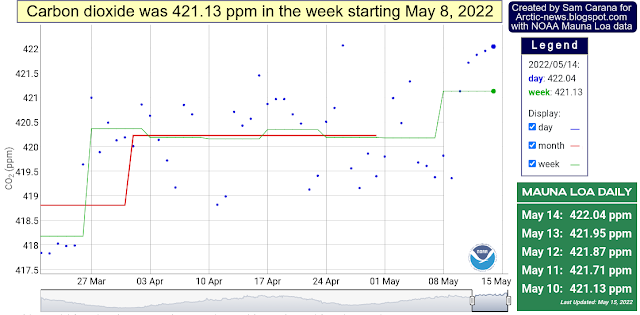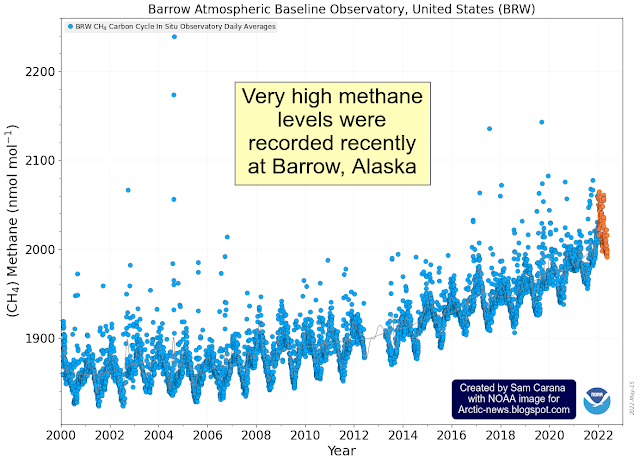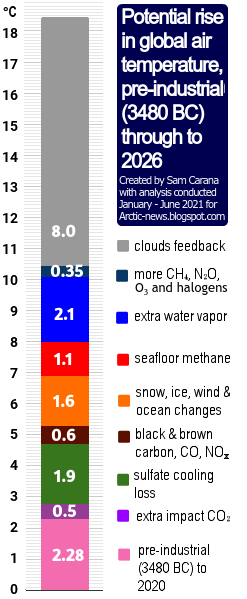The image below, from an animation by Zachary Labe, shows Arctic sea ice extent up to June 20, 2022, based on Vishop data. The yellow line is the year 2022. The white line shows extent for the year 2012, when it reached a record minimum in September. The blue line shows extent the year 2020, when the minimum in September was second lowest.
The image below, adapted from Vishop, shows that on June 23, 2022, global sea ice extent was at a record low for the time of year.
 |
| [ adapted from NOAA - click on images to enlarge ] |
El Niños typically occur every 3 to 5 years, according to NOAA and as also illustrated by the NOAA image below, so the upcoming El Niño can be expected to occur soon.
The NOAA image below indicates that going from the bottom of a La Niña to the peak of an El Niño could make a difference of more than half a degree Celsius (0.5°C or 0.9°F).
Furthermore, the rise in sunspots from May 2020 to July 2025 could make a difference of some 0.15°C (0.27°F). The next El Niño looks set to line up with a high peak in sunspots, in a cataclysmic alignment that could push up the temperature enough to cause dramatic sea ice loss in the Arctic, resulting in runaway temperature rise by 2026.
Multi-year Sea Ice
The NSIDC compilation below illustrates how much multi-year sea ice has already declined over the years. The top panel shows the age of Arctic sea ice for the March 12 to 18 period in (a) 1985 and (b) 2022. The oldest ice, greater than 4 years old, is in red. Plot (c) shows the timeseries from 1985 through 2022 of percent cover of the Arctic Ocean domain (inset, purple region) by different sea ice ages during the March 12 to 18 period.
On June 18, 2022, Arctic sea ice volume was among the lowest on record for the time of year, as illustrated by the image below, adapted from Polarportal.
The image on the right shows a trend pointing at zero Arctic sea ice volume by September 2027.
Note that the volume data in the image are averages for the month September — the minimum for each year is even lower. Furthermore, since zero volume implies zero extent, this indicates that a Blue Ocean Event (extent below 1 million km²) could happen well before 2027.
A 2019 analysis concludes that the latent heat tipping point gets crossed when the sea surface temperature anomaly on the Northern Hemisphere gets higher than 1°C above 20th century's temperature and when there is little or no thick sea ice left. As the image below indicates, the temperature anomaly of 1°C above the 20th century average looks set to be crossed in the course of the year 2021.
 |
| [ from the post Arctic Ocean invaded by hot, salty water ] |
The combination image below illustrates how much ocean heat is entering the Arctic Ocean from the Atlantic Ocean, heating up the sea ice from below.
The left panel shows the depth of the Arctic Ocean, with darker blue indicating greater depth.
In the right panel, the light blue, green and yellow colors indicate the thickest ice, located in the shallow waters off the coasts of North America and Greenland. The darker blue colors indicate where much of the sea ice has melted away, from below, as also illustrated by the one-month animation below showing sea ice thickness up to June 22, 2022, with an added 8 days of forecasts. The white color indicates where the sea ice has melted away entirely, e.g. in the Bering Strait and north of Siberia, mainly due to warm water from rivers entering the Arctic Ocean.
As the Latent Heat Tipping Point gets crossed, there may still be a thin layer of ice at the surface, at least as long as air temperatures are low enough to keep it frozen and as long as strong winds haven't pushed the sea ice out of the Arctic Ocean. This thin layer of ice will still consume some ocean heat below the surface, but at the same time it acts as a seal, preventing heat from the Arctic Ocean to enter the atmosphere. Even if a lot of sea ice remains, the situation is dangerous, if not even more dangerous. The continuing La Niña could cause a lot of thin sea ice to remain at the surface of the Arctic Ocean this year. The more sea ice remains, the less ocean heat can be transferred from the Arctic Ocean to the atmosphere over the Arctic Ocean, which means that more heat remains in the Arctic Ocean.
One huge danger is that, as the buffer disappears that until now has consumed huge amounts of ocean heat, more heat will reach methane hydrates at the seafloor of the Arctic Ocean, causing them to get destabilized and resulting in releases of methane from these hydrates and from free gas underneath that was previously sealed by the hydrates.
As the latent heat buffer of the sea ice underneath the surface disappears, more of this heat could then reach sediments at the seafloor of the Arctic Ocean, threatening eruptions to occur of seafloor methane (from hydrates and from free gas underneath the hydrates). The methane could similarly push up temperatures dramatically over the Arctic, and globally over the next few years.
The above 2014 image, from the feedbacks page, shows three of the numerous feedbacks that are accelerating warming in the Arctic. Feedback #1 is the albedo feedback. Feedback #14 refers to the loss of the Latent Heat Buffer and warming of the Arctic Ocean. Feedback #2 refers to methane releases.
Heatwaves look set to continue on the Northern Hemisphere, extending heat over the Arctic Ocean and thus affecting Arctic sea ice from above, while warm water from rivers will cause more melting at the surface, and while rising ocean heat will continue to cause more melting of the ice underneath the surface. If this continues, we can expect a new record low for sea ice in September 2022 and the joint loss of the latent heat buffer and the loss of albedo could push up temperatures dramatically over the Arctic, while the additional methane could similarly push up temperatures dramatically over the Arctic, and globally over the next few years.
 |
| [ The Buffer has gone, feedback #14 on the Feedbacks page ] |
Conclusion
Links
• NSIDC - Charctic
https://nsidc.org/arcticseaicenews/charctic-interactive-sea-ice-graph
• Zachary Labe - sea ice extent and concentration
https://sites.uci.edu/zlabe/arctic-sea-ice-extentconcentration
• Vishop sea ice data
https://ads.nipr.ac.jp/vishop/#/extent
• NSIDC - Springtime in the Arctic
https://nsidc.org/arcticseaicenews/2022/05/springtime-in-the-arctic
• NOAA - ENSO: Recent Evolution, Current Status and Predictions
https://www.cpc.ncep.noaa.gov/products/analysis_monitoring/lanina/enso_evolution-status-fcsts-web.pdf
• nullschool
https://earth.nullschool.net
• Albedo, latent heat, insolation and more
https://arctic-news.blogspot.com/p/extinction.html
• Climate Plan
https://arctic-news.blogspot.com/p/climateplan.html

















































